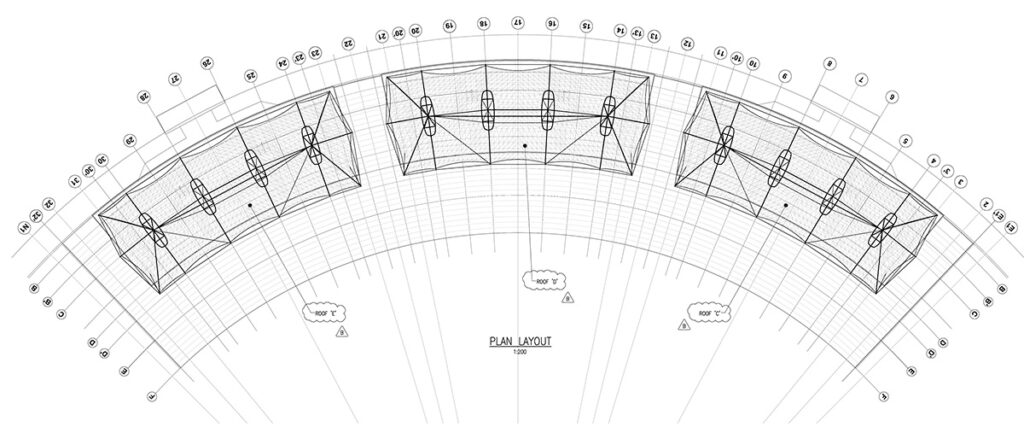Chepauk Stadium Grandstand
Project Details
Location: Chennai, India
Completion Date: April 2010
Size: 2050 sqm
Fabric: PTFE - Saint Gobain Sheerfill II
Client: The Tamil Nadu Cricket Association
The Chepauk Stadium Grandstand project was to provide shade for spectators of India’s second oldest cricket stadium. The shade canopies are 3 separate structures on each of the different parts stadium (officially named M. A. Chidambaram Stadium).
PTFE was chosen as it has excellent solar reflectance (up to 70%) to survive the high daily temperatures of Chennai. It also is very resistant to UV, perfect for long cricket test matches often played at the ground. The result of the project is a long lasting design that will continue to be relevant for decades to come.
The Chepauk Stadium Grandstand project was initiated with the aim of enriching the spectator experience at the M. A. Chidambaram Stadium, the second oldest cricket stadium in India. The primary challenge lay in the installation of large-scale elevated shade structures over three multi-tier grandstands, presenting a series of interesting structural obstacles. Designed to offer shade and weather protection, the tensile membrane shade canopies were strategically positioned to mitigate the intense summer heat and monsoon rains characteristic of Chennai’s climate.
The Brief
The project’s directive was to provide a series of lightweight grandstand roofs to supported by a minimalist steel structure. A particularly complex aspect emerged during the design phase, as the client specified a requirement for only two main footings for each stand cover, resulting in a significant 28m span between each supporting column. Consequently, a sophisticated cable truss system was devised to fortify these uprights and to accommodate the loading of the four substantial conical sections, per grandstand.
The Concept

The Materials
In addressing the structural demands, the architects opted for Polytetrafluoroethylene (PTFE) for the canopy material. Chosen for its exceptional solar reflectance capacity, reaching up to 70% of solar rays, PTFE proved vital in maintaining a cool environment beneath the canopies, crucial for ensuring spectator comfort in Chennai’s high temperatures. The material’s commendable resistance to UV radiation also proved pivotal, guaranteeing the durability and aesthetic integrity of the canopies over prolonged periods, even during extended cricket test matches.
The project’s collaborative effort between British architects, MakMax engineers from Australia, membrane fabrication at the Taiyo Kogyo facility in Japan, and Indian construction teams, facilitated the seamless integration of the material within the structural design, enhancing the project’s overall success.
The Result
The successful execution of the Chepauk Stadium Grandstand project culminated in a design that combines functionality with longevity. Reinforced by the enduring properties of PTFE, the project not only fulfilled the immediate requirement for shade and comfort but also ensured the sustained relevance of the structures for years to come.
With the later addition of six additional stadium covers to the initial three structures, the venue now boasts a total of nine covered spectator stands, all unified by a continuous design that seamlessly integrates with the stadium’s aesthetic appeal. The client’s satisfaction with the final product stands as a testament to the project’s success, solidifying the M. A. Chidambaram Stadium’s position as an iconic sporting landmark in India.


